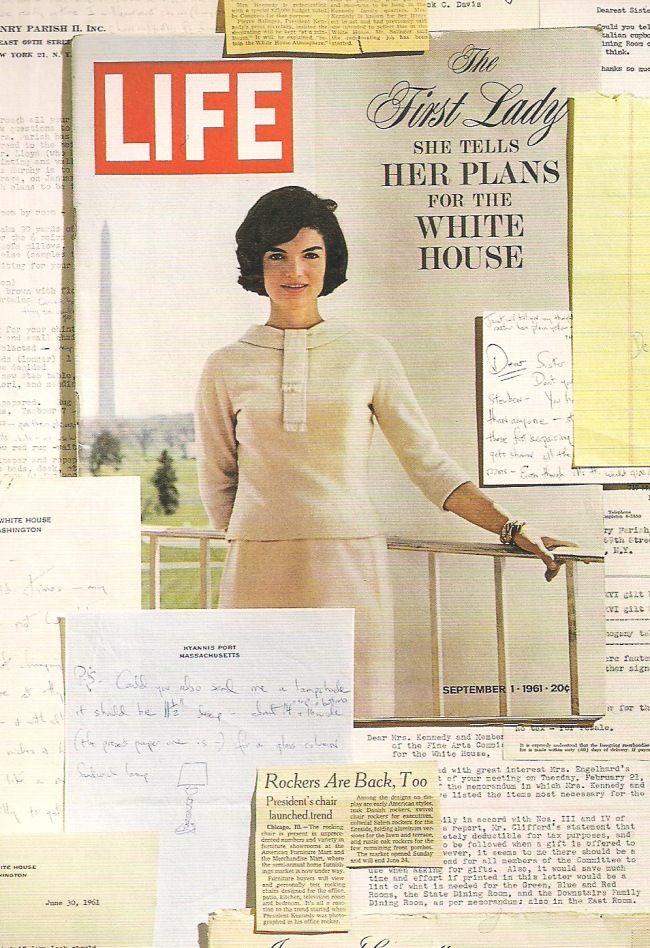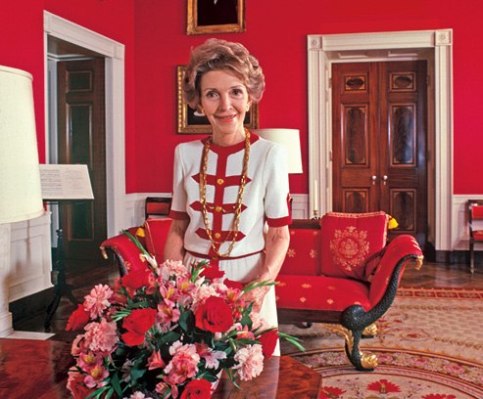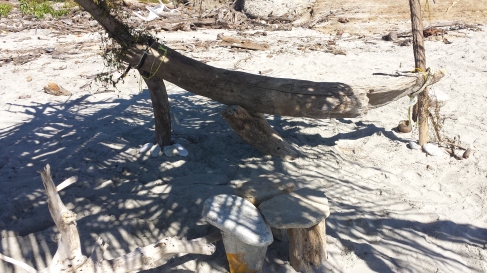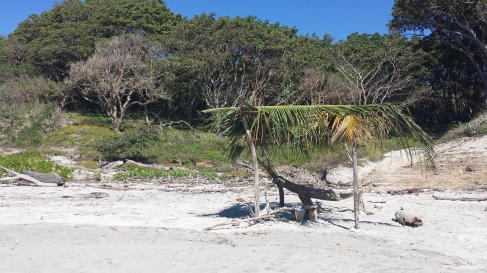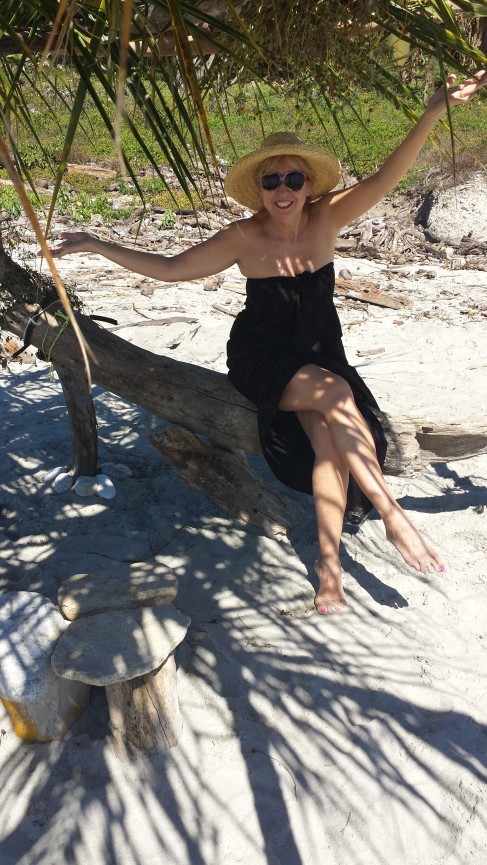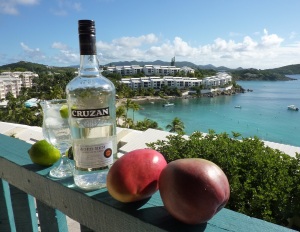At 4 years old my teeny cousin, Katherine whom I nicknamed Katie-belle, took my hand as we ventured forth with great discovery stepping down into the carport of our beach house. With commiserating whispers, like the two adventurers that we were that night, we exchanged queries about where we were headed and what we might find and she said ” I Wonder…”
“So what?” you might say. What’s such a big deal about that? Well the concept of wondering, being able to ponder with amazement at what might result, was astonishing to me coming from the mouth of such a young child.
When we returned upstairs to join the group, I was eager to share my amazement about her simple phrase, “I wonder.” I exclaimed “She wonders!” Repeating it incredulously about 5 times!
Today she is a dedicated grown-up pursuing exciting adventures in education as she navigates the University system and teaches students with a creative approach that captivates and engages beyond their expectations.
What is wonder? What is wonderful? Yesterday I visited the Renwick Gallery in Washington, D.C. . The current exhibit is called WONDER. 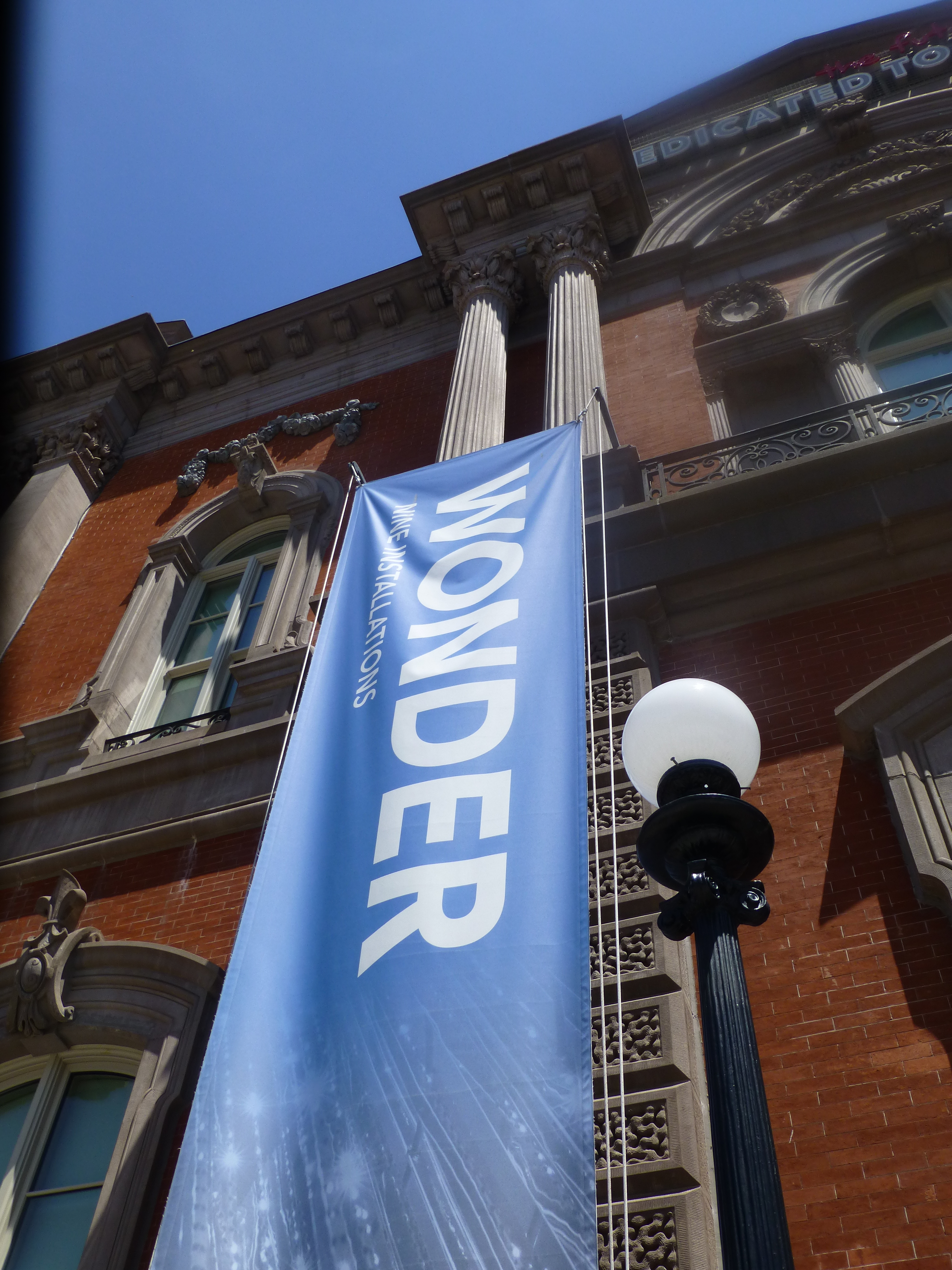 It truly is a wonderment for all ages. This architecturally magnificent building designed in 1859 by James Renwick, in the then chic Parisian Second Empire Style, is the elegant backdrop for a most progressive and creative collection of present day modern artists’ works. Diverse examples, of spectacular displays using simple materials, brought to life in forms unexpected – of grand proportion and thrilling magnitude. Although my learned and previewer cousin had introduced me to the exhibit in advance, it captivated and engaged beyond my expectations.
It truly is a wonderment for all ages. This architecturally magnificent building designed in 1859 by James Renwick, in the then chic Parisian Second Empire Style, is the elegant backdrop for a most progressive and creative collection of present day modern artists’ works. Diverse examples, of spectacular displays using simple materials, brought to life in forms unexpected – of grand proportion and thrilling magnitude. Although my learned and previewer cousin had introduced me to the exhibit in advance, it captivated and engaged beyond my expectations.
This grand yet intimate edifice welcomes and encourages close observation of both itself and its contents. The spectacular main staircase, centered upon entry, presents a brilliant coral red carpet installed with a curvy, serpentine migration up to the second level. Ooh – if copying is cool and emulating is the greatest form of compliment – I will be looking for an opportunity to specify a similarly whimsical installation. 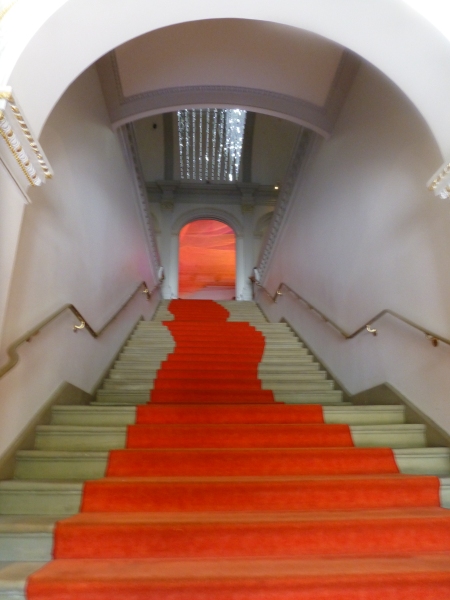
Glittering overhead, spanning the entire length of the staircase, is a rectangular chandelier of mirror-like stainless steel punctuated with little LED lights blinking in random patterns. 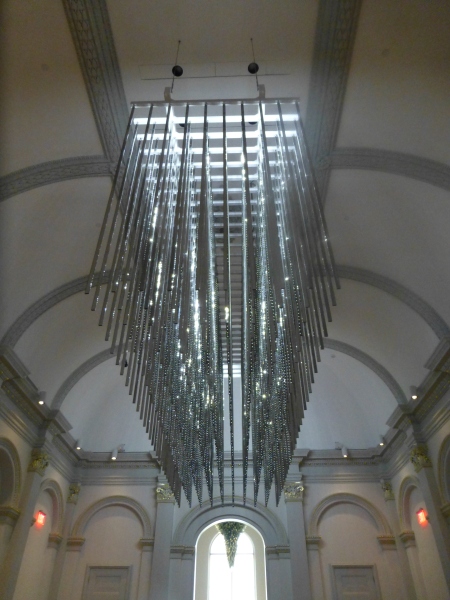 The glitz and bling make such a striking, formal, contemporary statement in this expansive volume that it startles with joyful contrast. The artist, Leo Villareal of whom I had heard in advance, was originally from Albuquerque – where we now call home. A remote desert origination transplanted into the fast pace of the urban centers of the east coast resulting in this shiny experimentation with light, form and wonderfully reflective surfaces. Villareal melds basic high-tech coding to use his own algorithm of the binary system 1s and 0s communicating to the lights when to turn off and turn on – yet sequences that are never exactly repeated .
The glitz and bling make such a striking, formal, contemporary statement in this expansive volume that it startles with joyful contrast. The artist, Leo Villareal of whom I had heard in advance, was originally from Albuquerque – where we now call home. A remote desert origination transplanted into the fast pace of the urban centers of the east coast resulting in this shiny experimentation with light, form and wonderfully reflective surfaces. Villareal melds basic high-tech coding to use his own algorithm of the binary system 1s and 0s communicating to the lights when to turn off and turn on – yet sequences that are never exactly repeated .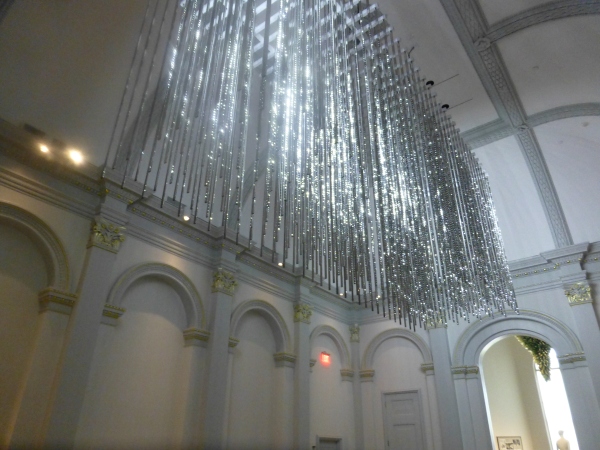 It’s not just your linear code of characters that is read on a screen – here it is an artistic experience shared by all who look up in this gallery’s exciting exhibit.
It’s not just your linear code of characters that is read on a screen – here it is an artistic experience shared by all who look up in this gallery’s exciting exhibit.
Straight ahead, through the massive opening to the next exhibit hall, was the wispy fishnet-like rainbow of woven warm-colored fiber representing both wonder and danger. Artist Janet Echelman’s inspiration is from a map of the energy released across the Pacific Ocean during the Tohoku earthquake and tsunami on March 11, 2011. A natural disaster so devastating that it shifted the earth on its axis and cost us a fraction of a second in time. Surreal? Sci-fi? No, it really happened. Beauty and grace depicting a horrific event. 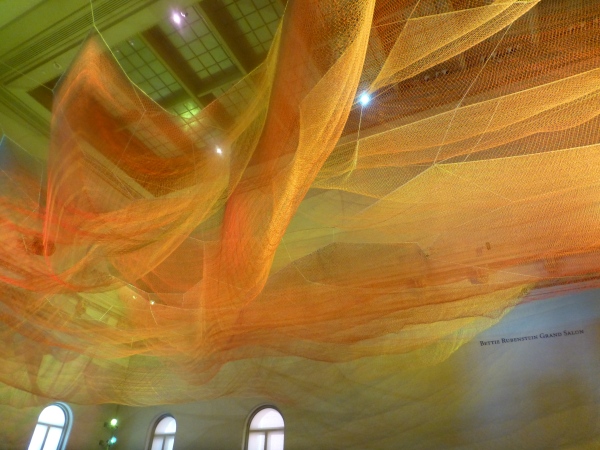 Large scaffolding at the end of the room suggests the manual installation that was required to suspend this wondrous drape catching light and glowing with golden aura.
Large scaffolding at the end of the room suggests the manual installation that was required to suspend this wondrous drape catching light and glowing with golden aura. 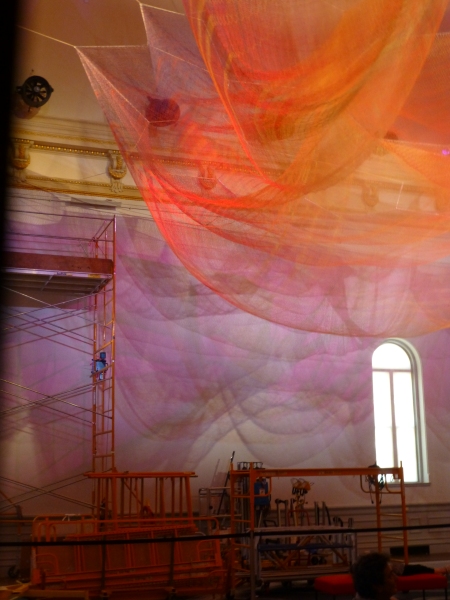
The lower level still had wonders to explore starting with the magical woven willow saplings – creations of artist Patrick Dougherty. He has wound these great lengths of supple branches to form Hobbit – like holes of imaginary forest habitats. 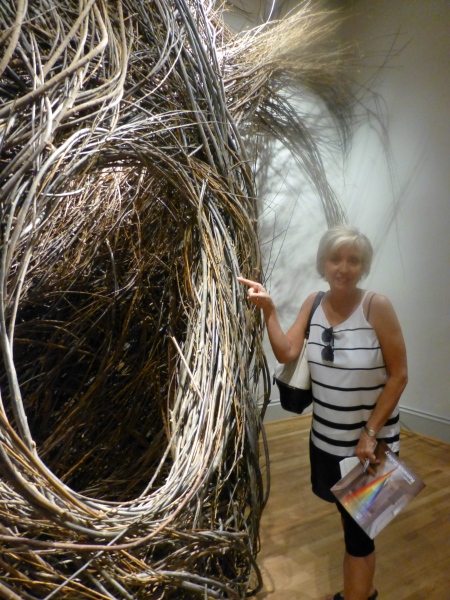 We were at once drawn into these cozy nurturing cubbies of what appeared to be nature – not forms created by man. Nature. Organic and raw, elegant and graceful winding toward the far reaches of the very high ceilings. Like a sculptor who says that the stone dictates what it wants to be and how he carves it – Dougherty knows that the long willow branches have a true will and bend their own way challenging him to work with them toward that goal of partnership with nature. The beauty is in the end result. People of all ages wandered in and out, peeking through window-like openings pretending to be exploring an enchanted forest of wonder.
We were at once drawn into these cozy nurturing cubbies of what appeared to be nature – not forms created by man. Nature. Organic and raw, elegant and graceful winding toward the far reaches of the very high ceilings. Like a sculptor who says that the stone dictates what it wants to be and how he carves it – Dougherty knows that the long willow branches have a true will and bend their own way challenging him to work with them toward that goal of partnership with nature. The beauty is in the end result. People of all ages wandered in and out, peeking through window-like openings pretending to be exploring an enchanted forest of wonder.
Next – stacked index cards- really? 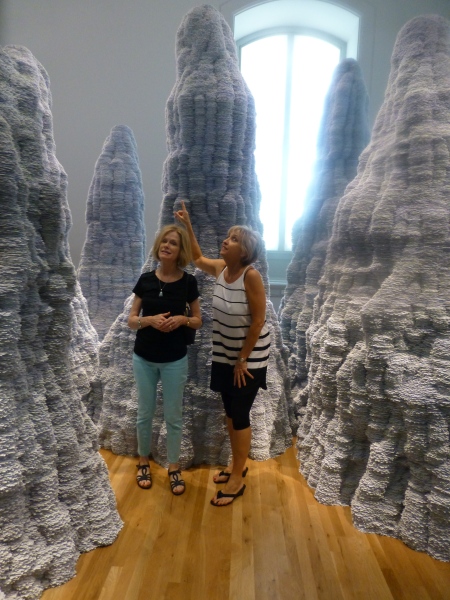 Have you ever experienced Tent Rocks?
Have you ever experienced Tent Rocks? 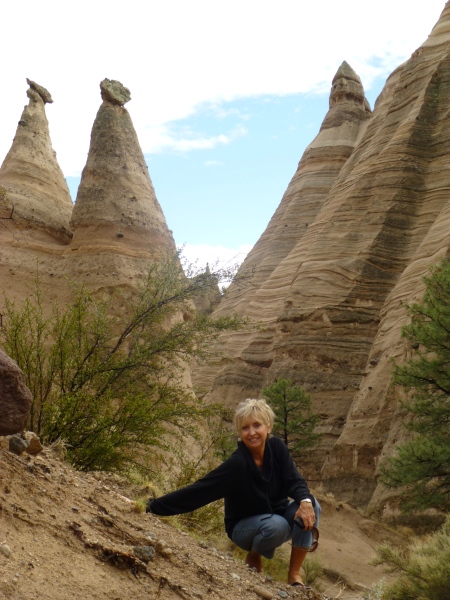 Have you ever looked upward and around and through the magnificent forms created by nature eroding the earth’s strata revealing layers of color and creating spires of rocky towers? It is a magic land just south of Cochiti in a very unexpected pocket of nature’s magnificence in our Land of Enchantment. And the spires that artist Tara Donovan created with stacks of index cards – an overwhelming accumulation of millions of index cards suggest grey spires replicating nature’s wonders in the canyons among the spires of the Tent Rocks.
Have you ever looked upward and around and through the magnificent forms created by nature eroding the earth’s strata revealing layers of color and creating spires of rocky towers? It is a magic land just south of Cochiti in a very unexpected pocket of nature’s magnificence in our Land of Enchantment. And the spires that artist Tara Donovan created with stacks of index cards – an overwhelming accumulation of millions of index cards suggest grey spires replicating nature’s wonders in the canyons among the spires of the Tent Rocks. 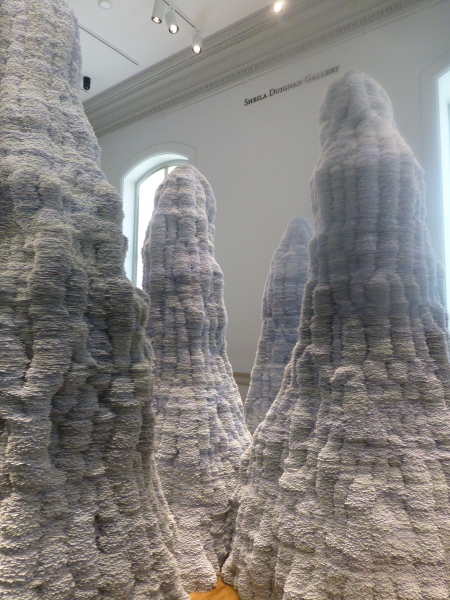 It’s as though a photographer captured this natural formation in black and white. Donovan’s interpretations are tones of grey as a result of the stacked white index cards with slivers of shadow sucking away light in between each of them. Clustered and staggering in height, the “Untitled” towers are inviting to walk amidst and pass between, winding around them like a tourist or explorer or perhaps inhabitant in ages past and present as they have stood for ages.
It’s as though a photographer captured this natural formation in black and white. Donovan’s interpretations are tones of grey as a result of the stacked white index cards with slivers of shadow sucking away light in between each of them. Clustered and staggering in height, the “Untitled” towers are inviting to walk amidst and pass between, winding around them like a tourist or explorer or perhaps inhabitant in ages past and present as they have stood for ages.
Snap out of it and see what is glowing like a fine fiber sail in the sunset in the next room. Stretching upward and crossing midway are thousands of incredibly fine threads woven from small hooks on the base. 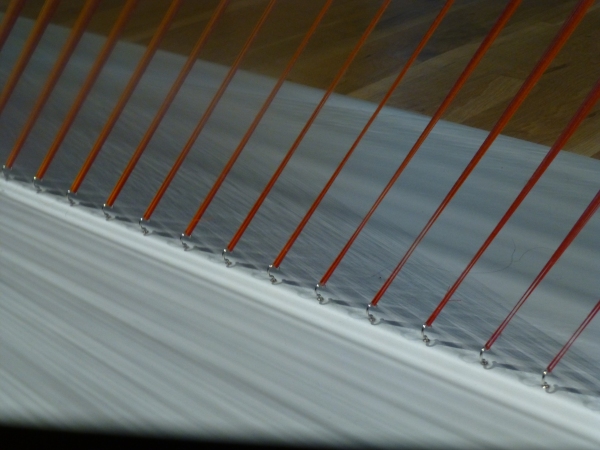 How could a human working only by hand – without computer generated machines digitally fabricating such perfection create this finished piece that we are studying with such wonder? How can this fine tedious seemingly impossible count of thousands of threads be executed with such grandeur and grace by one mere mortal?
How could a human working only by hand – without computer generated machines digitally fabricating such perfection create this finished piece that we are studying with such wonder? How can this fine tedious seemingly impossible count of thousands of threads be executed with such grandeur and grace by one mere mortal? 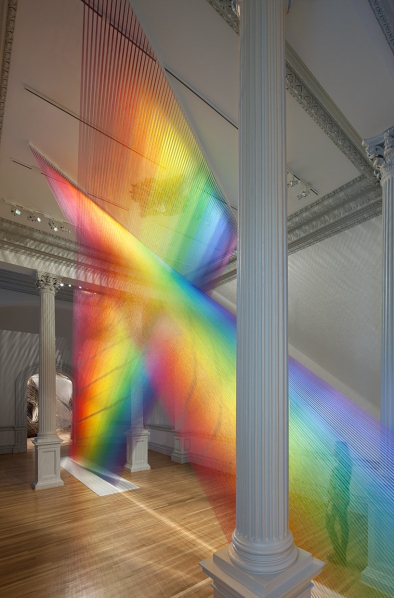 The artist Gabriel Dawe transcends our ability to comprehend the exactness of his beautiful accomplishment with extraordinary patience, precision and creative foresight to imagine the end result and bring it to fruition. It is a wondrous, luminous sculpture of rainbow colored threads inspired by the skies of his native Mexico and current home in East Texas. The fine weavings also inspired by his Mexican heritage are interpreted, stretched and exaggerated here reflecting the light and spectrum of color from its base to ceiling.
The artist Gabriel Dawe transcends our ability to comprehend the exactness of his beautiful accomplishment with extraordinary patience, precision and creative foresight to imagine the end result and bring it to fruition. It is a wondrous, luminous sculpture of rainbow colored threads inspired by the skies of his native Mexico and current home in East Texas. The fine weavings also inspired by his Mexican heritage are interpreted, stretched and exaggerated here reflecting the light and spectrum of color from its base to ceiling. 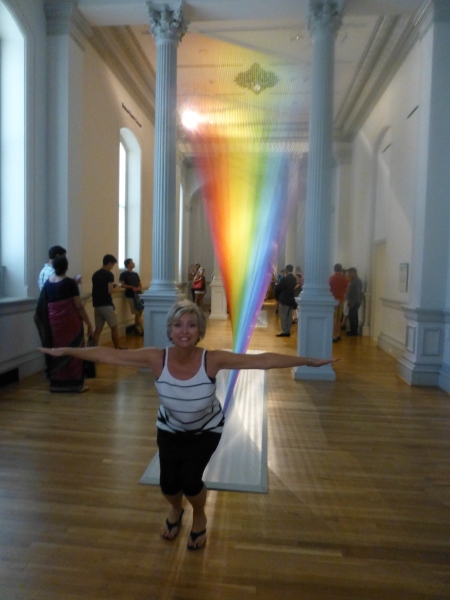
We missed a couple of early installations of WONDER but were thrilled by today’s adventure. We had many opportunities to wonder…wonder how the artists conceive of their fantastic ideas and actually build their dreams to share with the world. We wondered what it takes to spark that creativity and passion that requires commitment and demands such unfailing determination. We wondered about those who collect these talents and curate these exhibits for the joy of so many. We wondered about the practical side of marketing these concepts to support the artists and this amazing accommodation started so many years ago by a true visionary William W. Corcoran.
My next blog will trace the history of this wonderful architectural treasure, the Renwick, and share more of the day’s discoveries that you might visit and experience as you tour my birthplace – our Nation’s Capital.

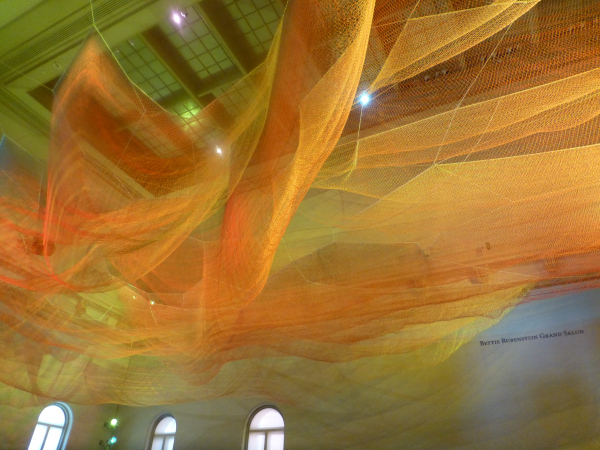

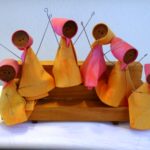
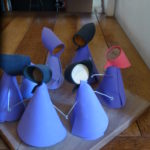
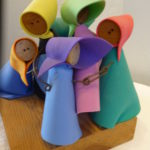
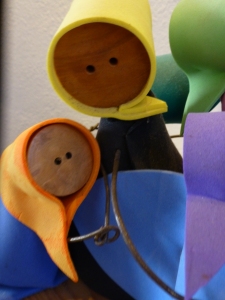
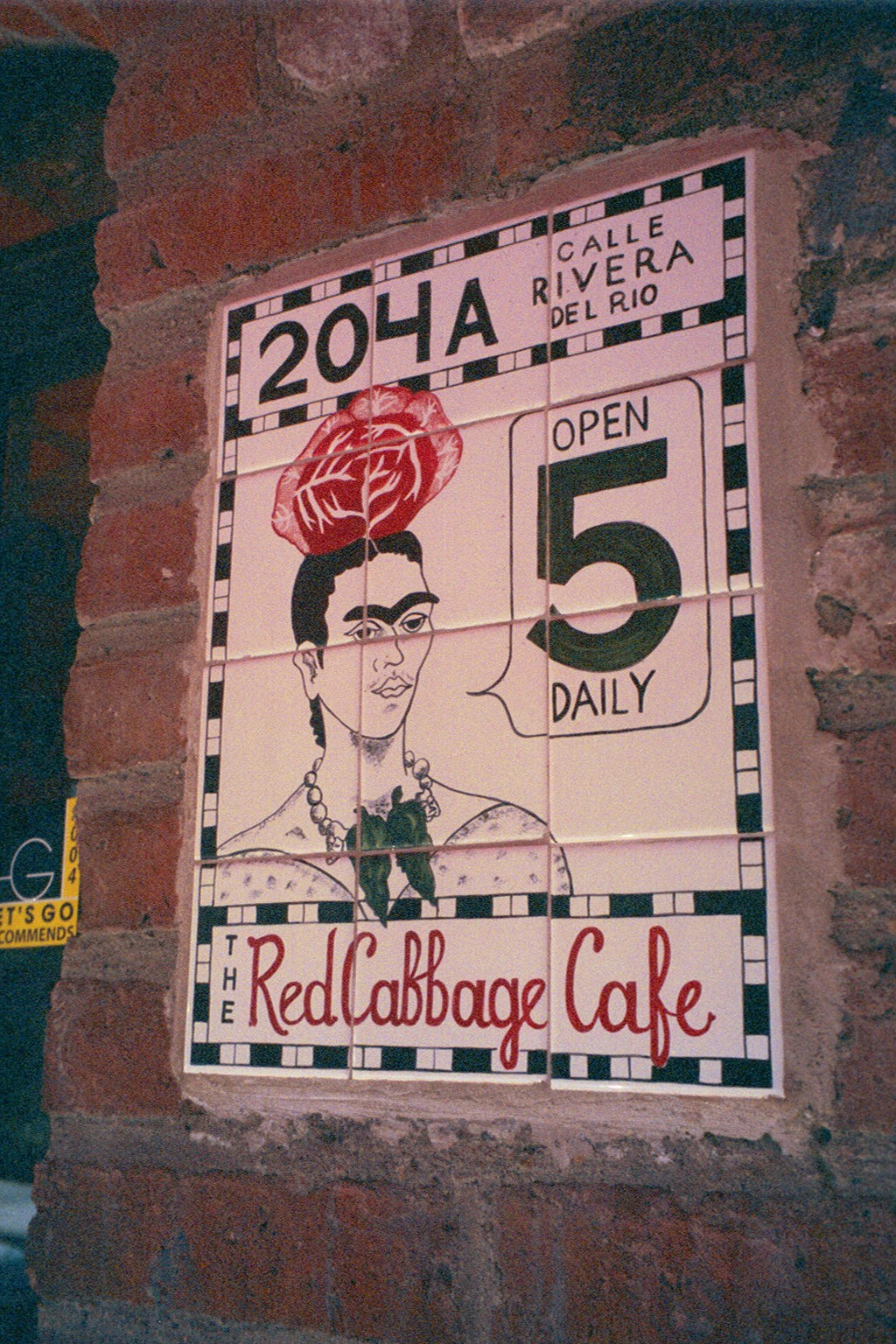
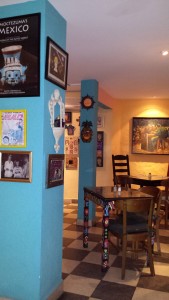 At night this place buzzes with animated conversations and is alive with color and funky memorabilia, art and posters, collages of collectibles all on brilliantly painted walls creating an eclectic artistic interior of fun and festivity. But on this morning, the room is dormant save the three other guests waiting to participate in the morning’s class.
At night this place buzzes with animated conversations and is alive with color and funky memorabilia, art and posters, collages of collectibles all on brilliantly painted walls creating an eclectic artistic interior of fun and festivity. But on this morning, the room is dormant save the three other guests waiting to participate in the morning’s class.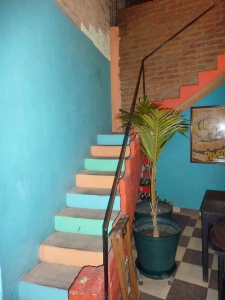 Daylight streams from above and we ascend past more brilliantly painted walls to a second floor open to the sky onto a patio rimmed with potted herbs and flowering plants.
Daylight streams from above and we ascend past more brilliantly painted walls to a second floor open to the sky onto a patio rimmed with potted herbs and flowering plants. 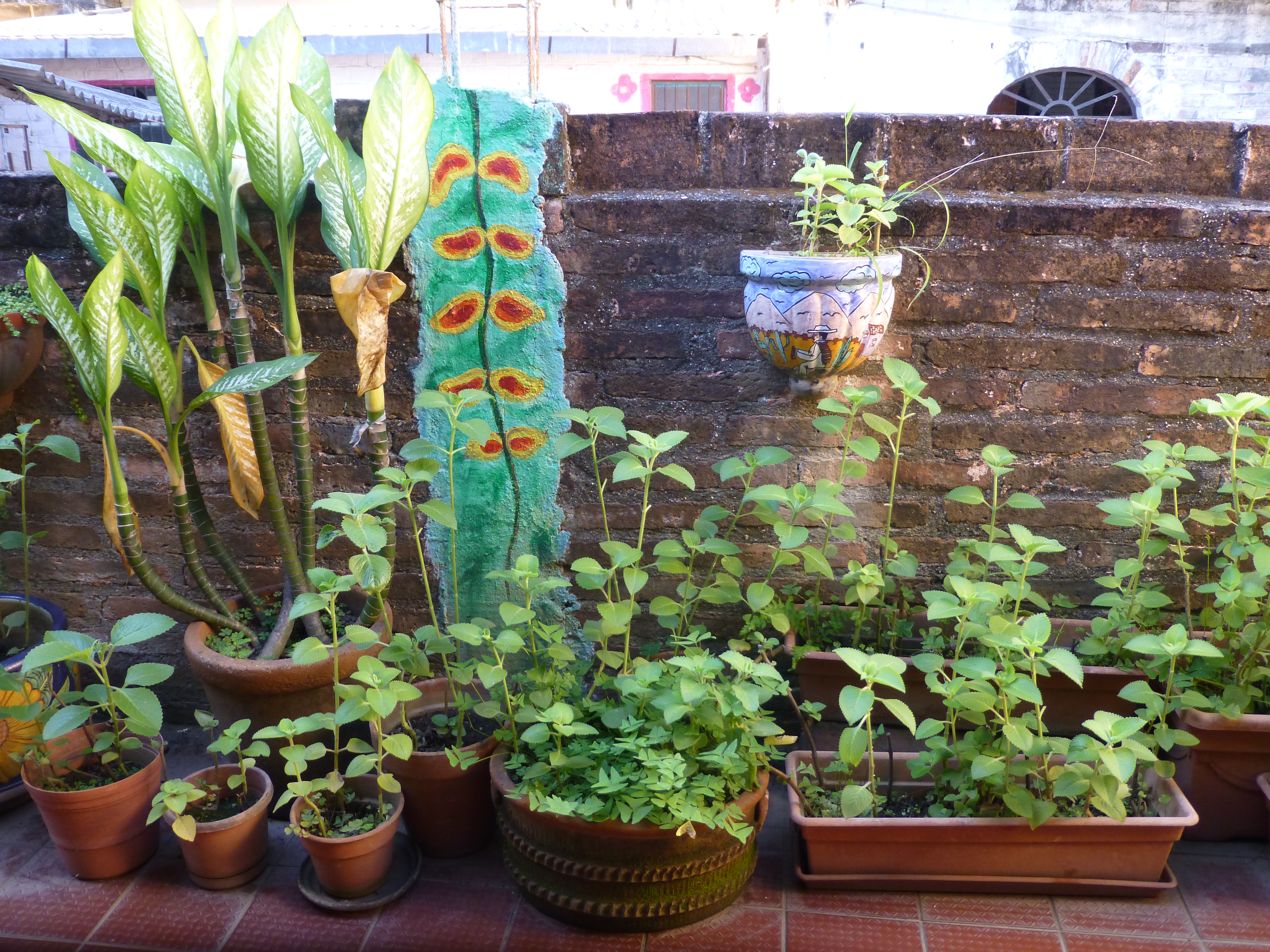 To the right we realize that the rest of the space is undercover, yet always exposed to the elements from that one open east-facing orientation.
To the right we realize that the rest of the space is undercover, yet always exposed to the elements from that one open east-facing orientation.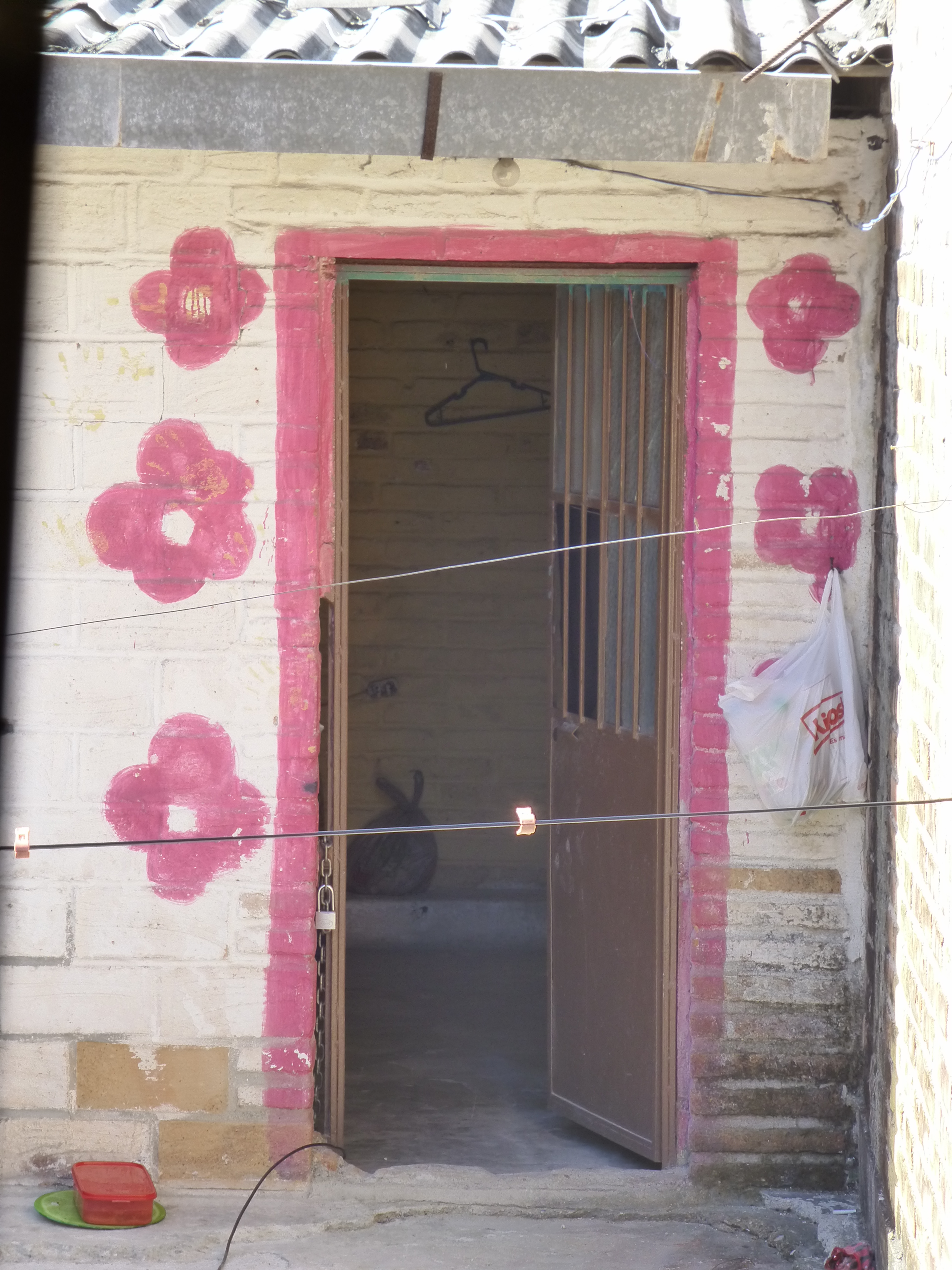 The surrounding area is quite run-down and depressed, yet this jewel of a creative kitchen space shines boldly amidst the impoverished surrounds.
The surrounding area is quite run-down and depressed, yet this jewel of a creative kitchen space shines boldly amidst the impoverished surrounds. 
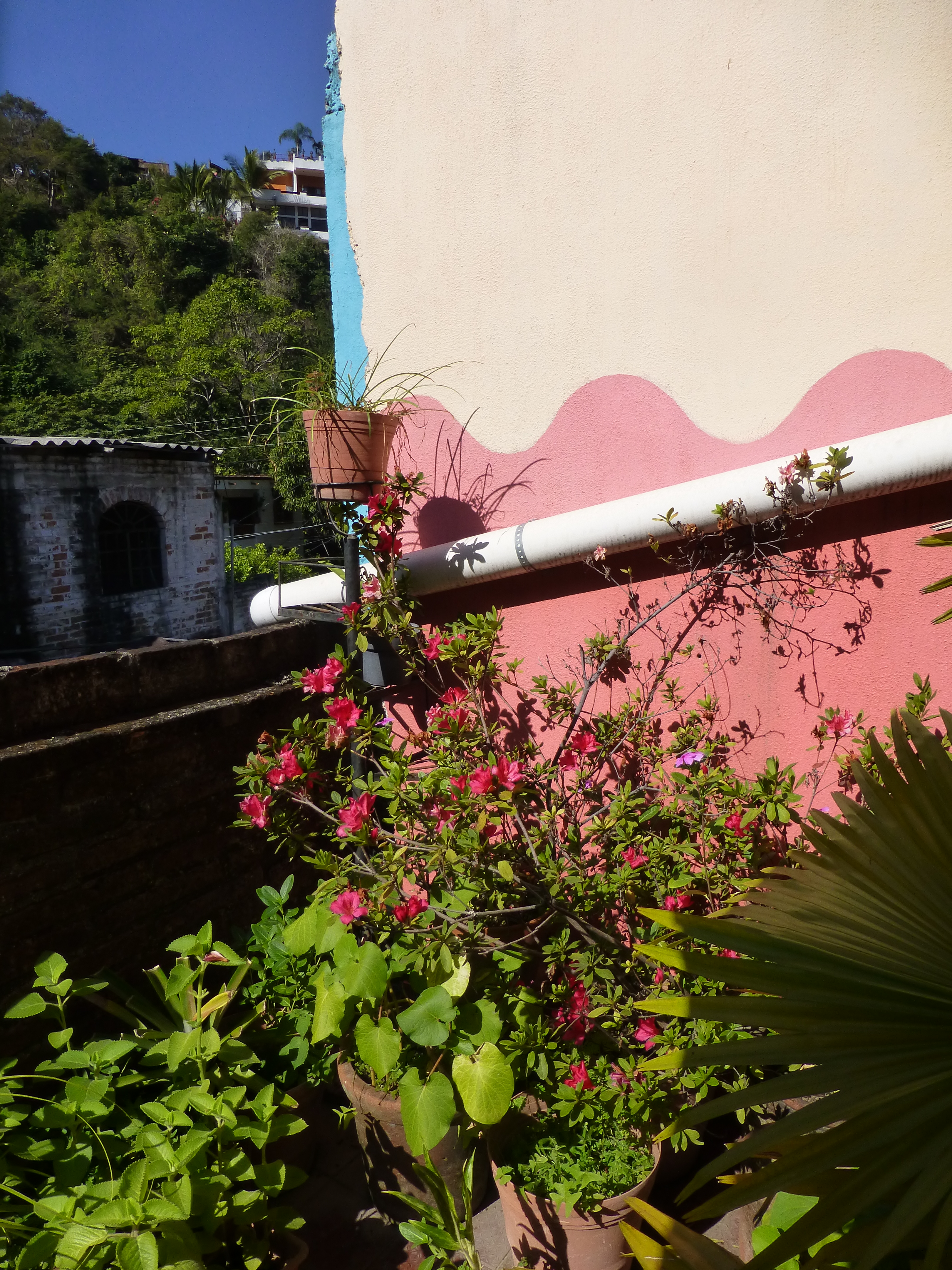
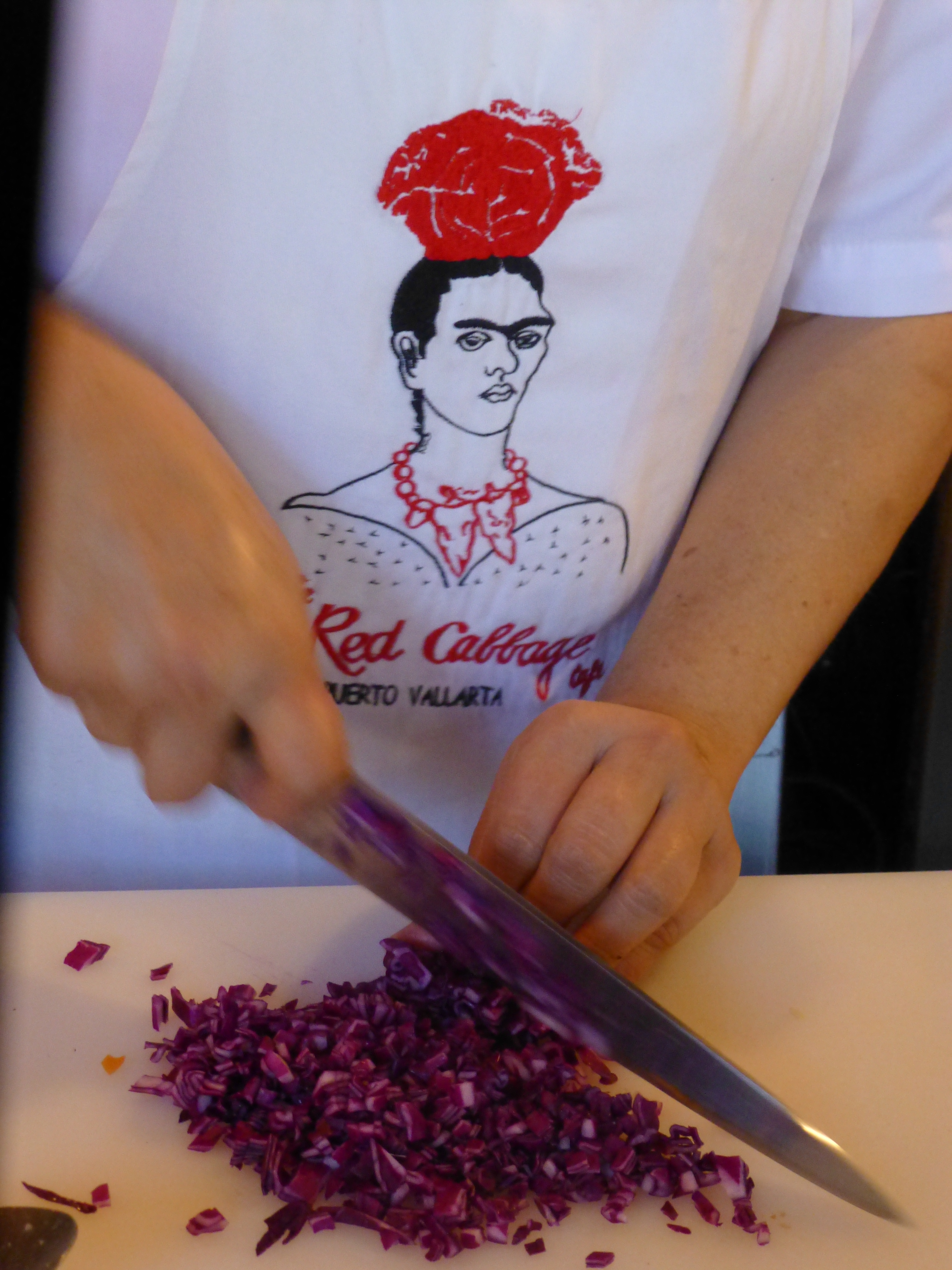
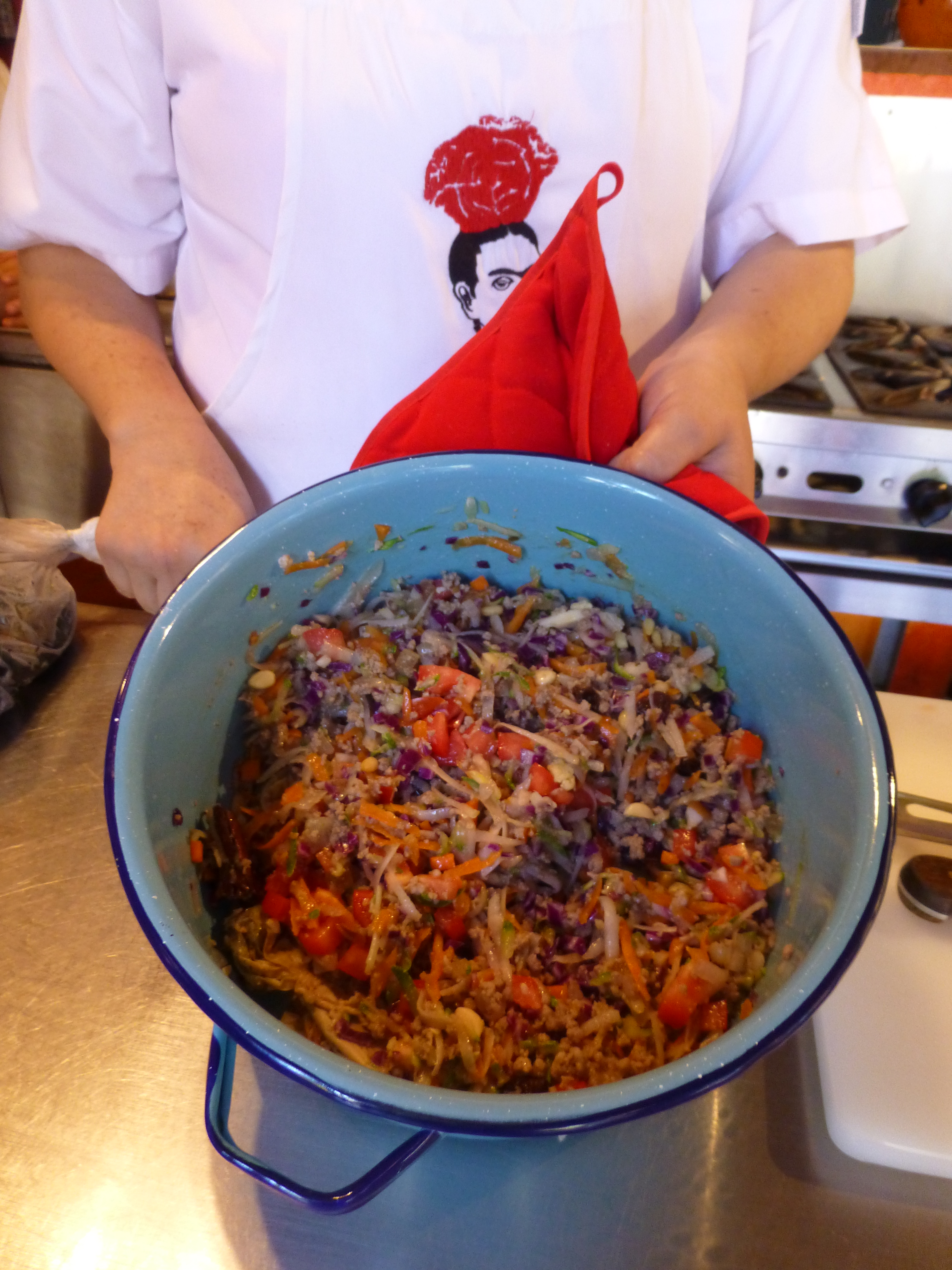

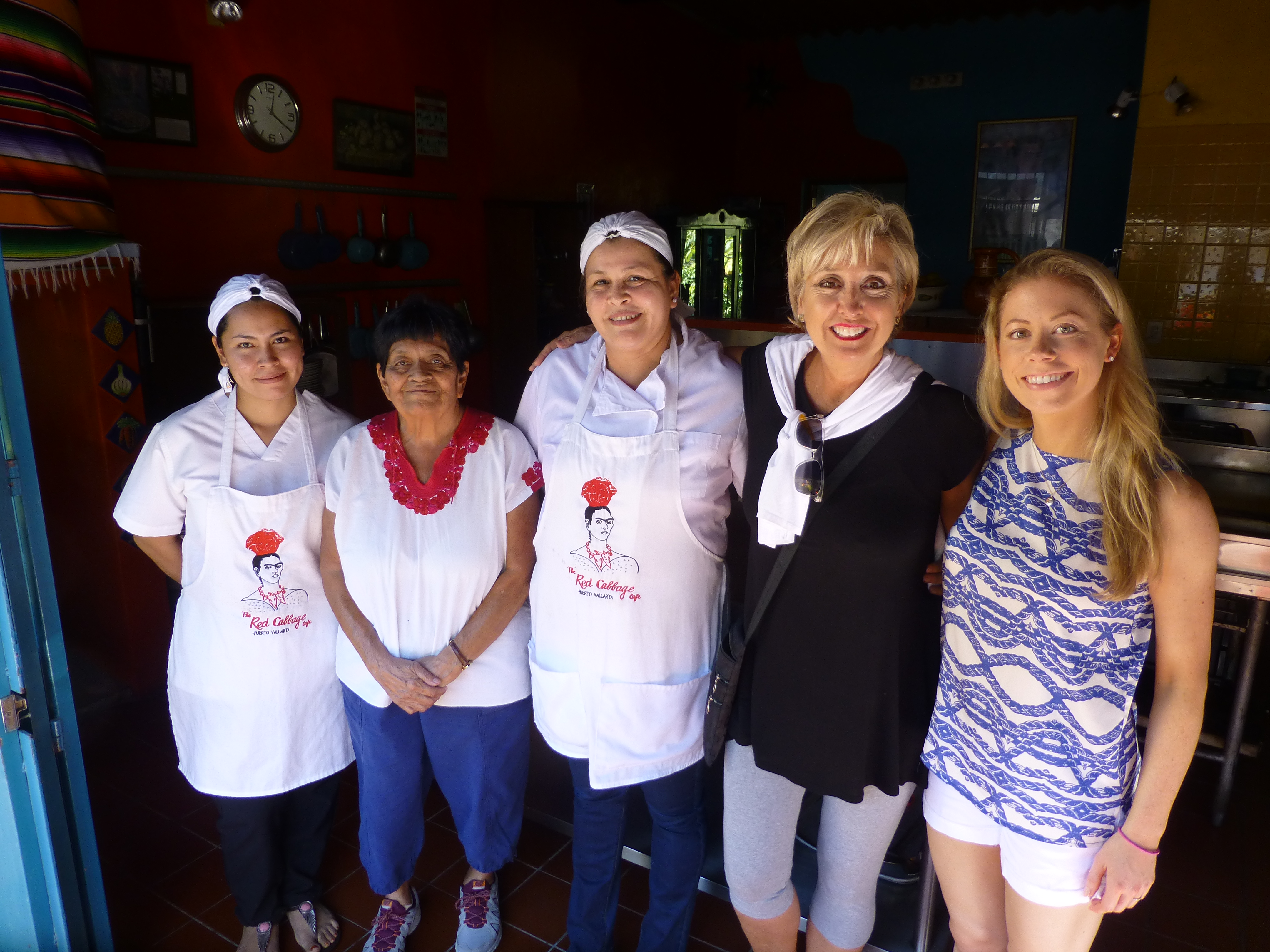
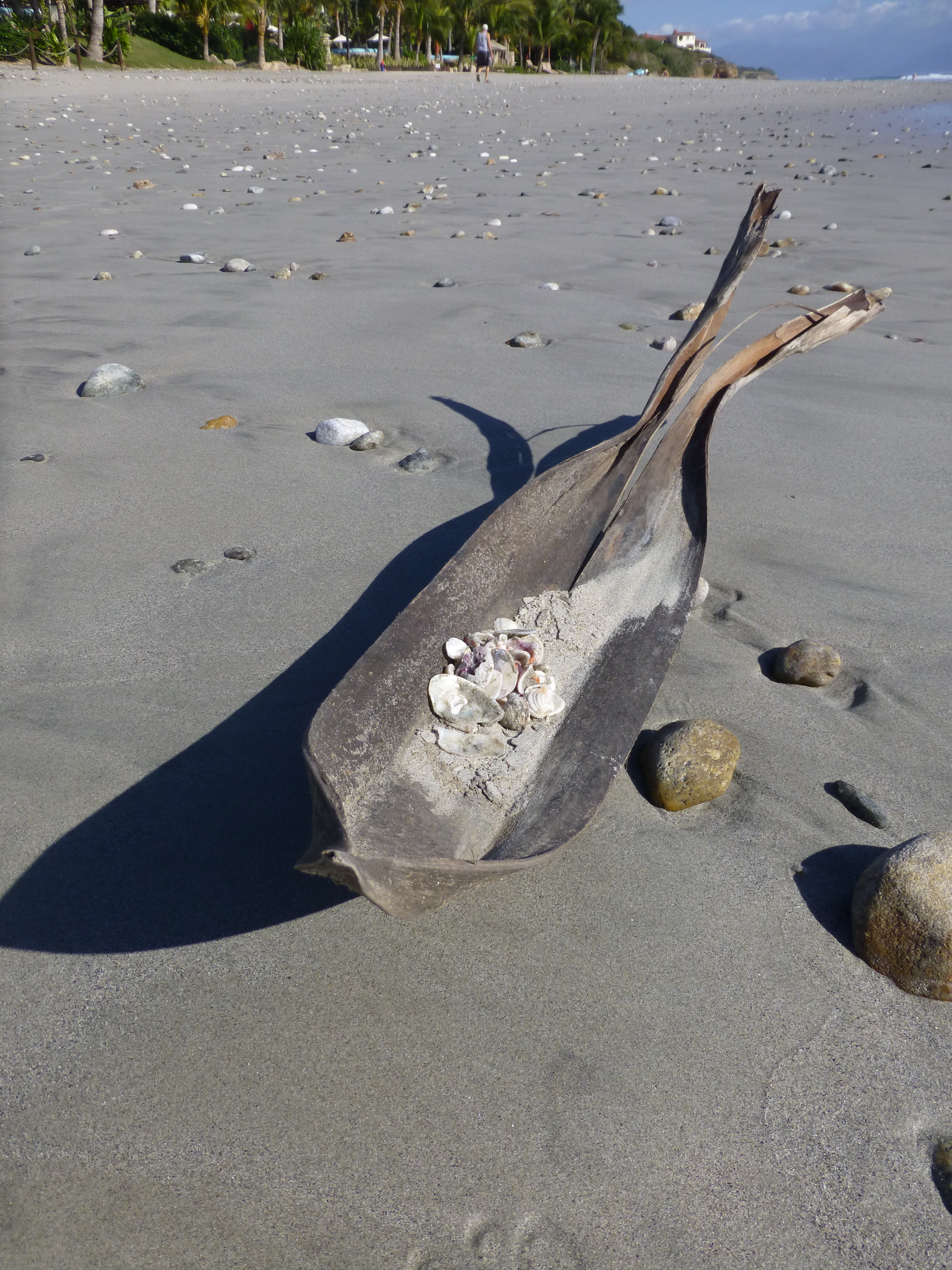
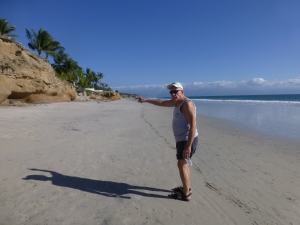
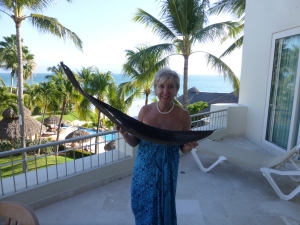
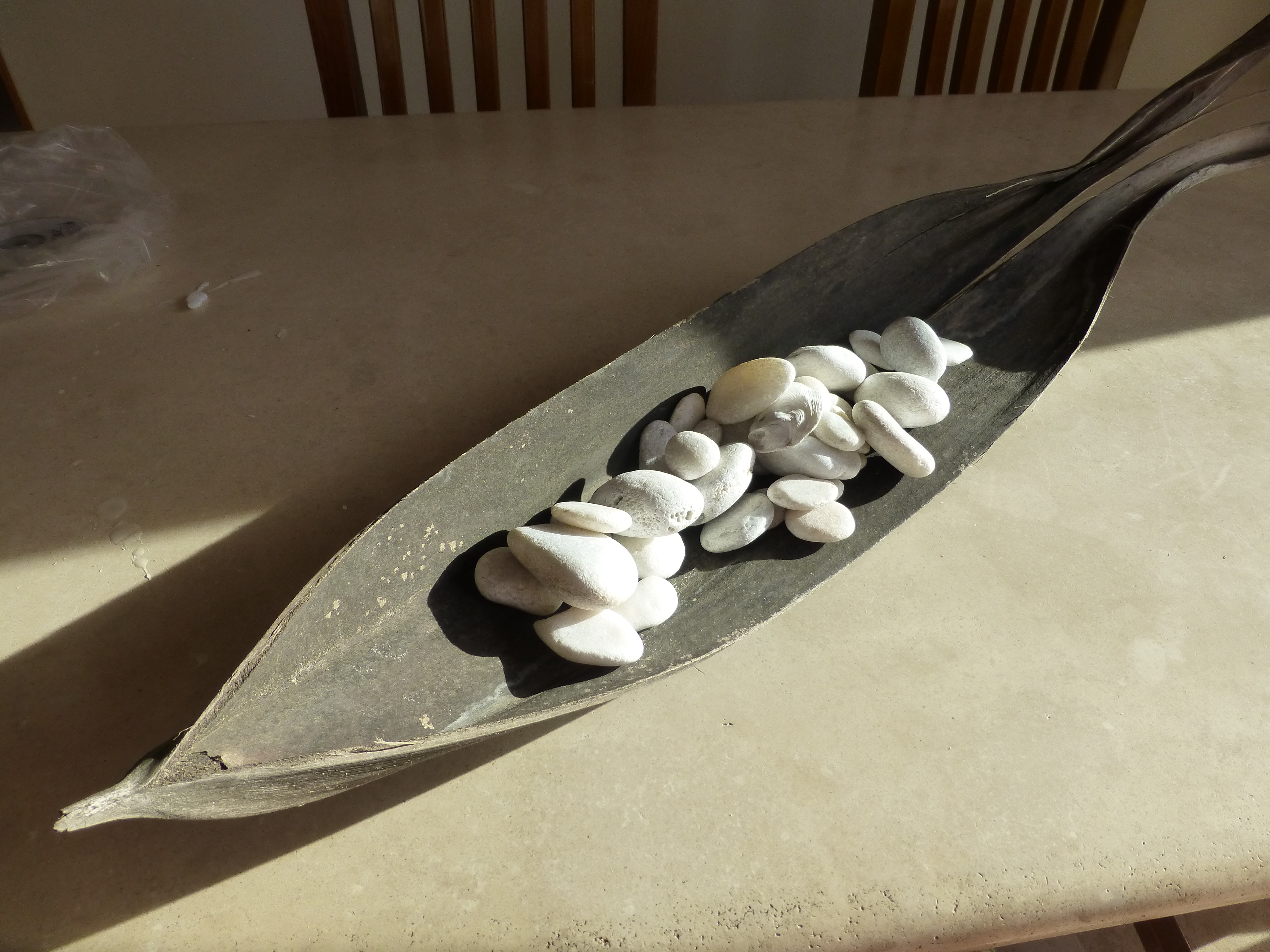
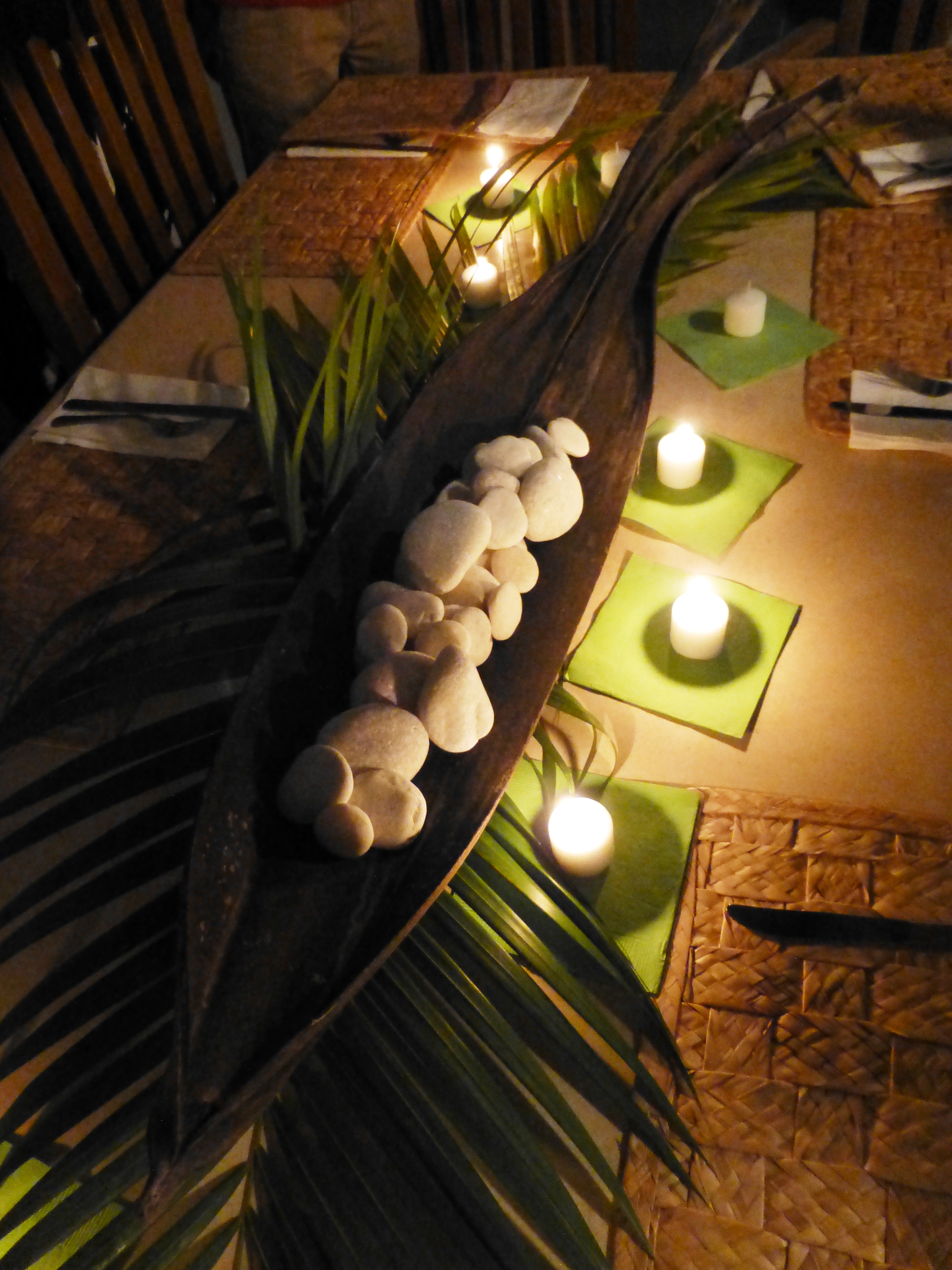
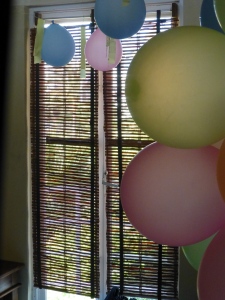
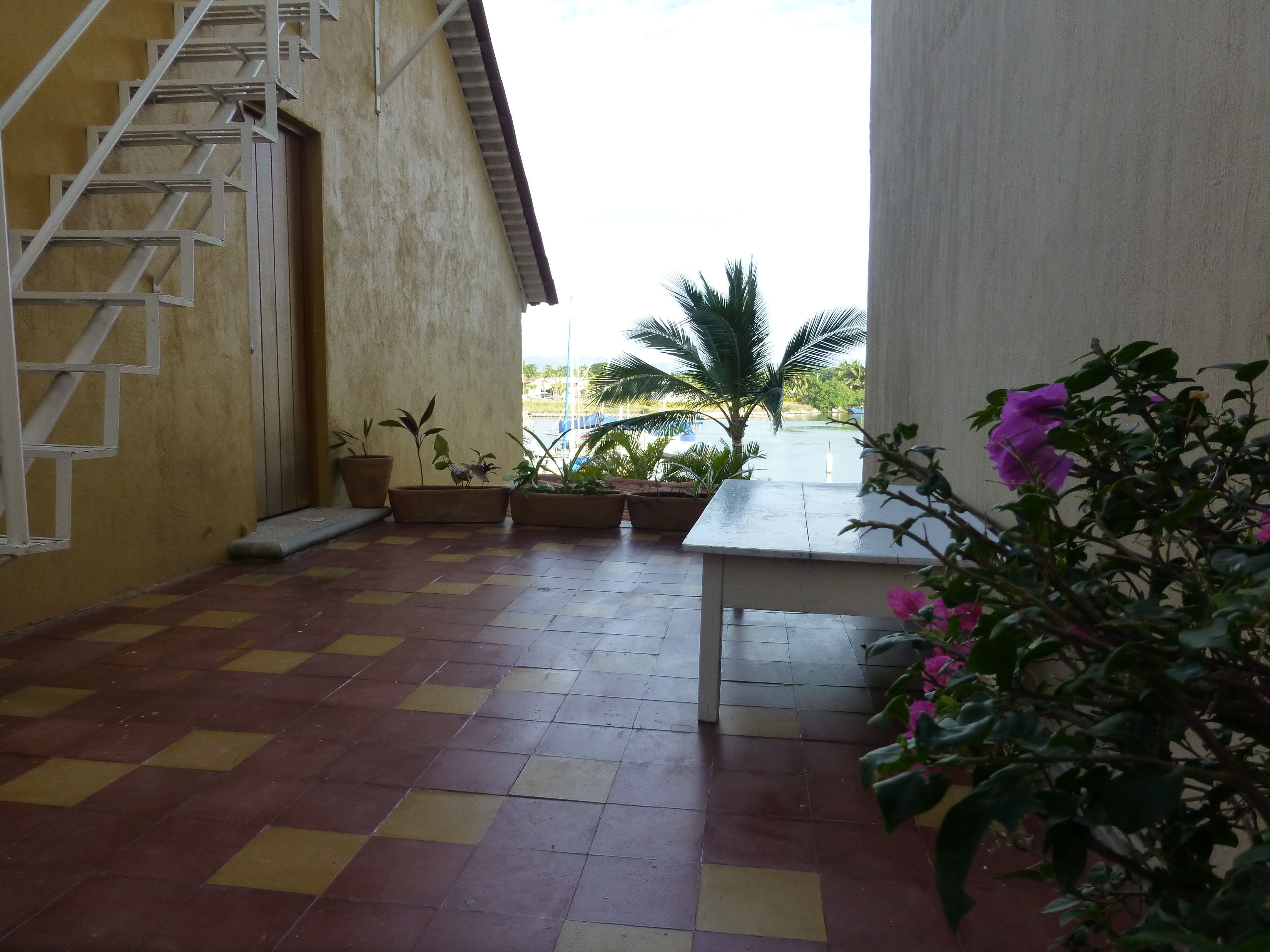
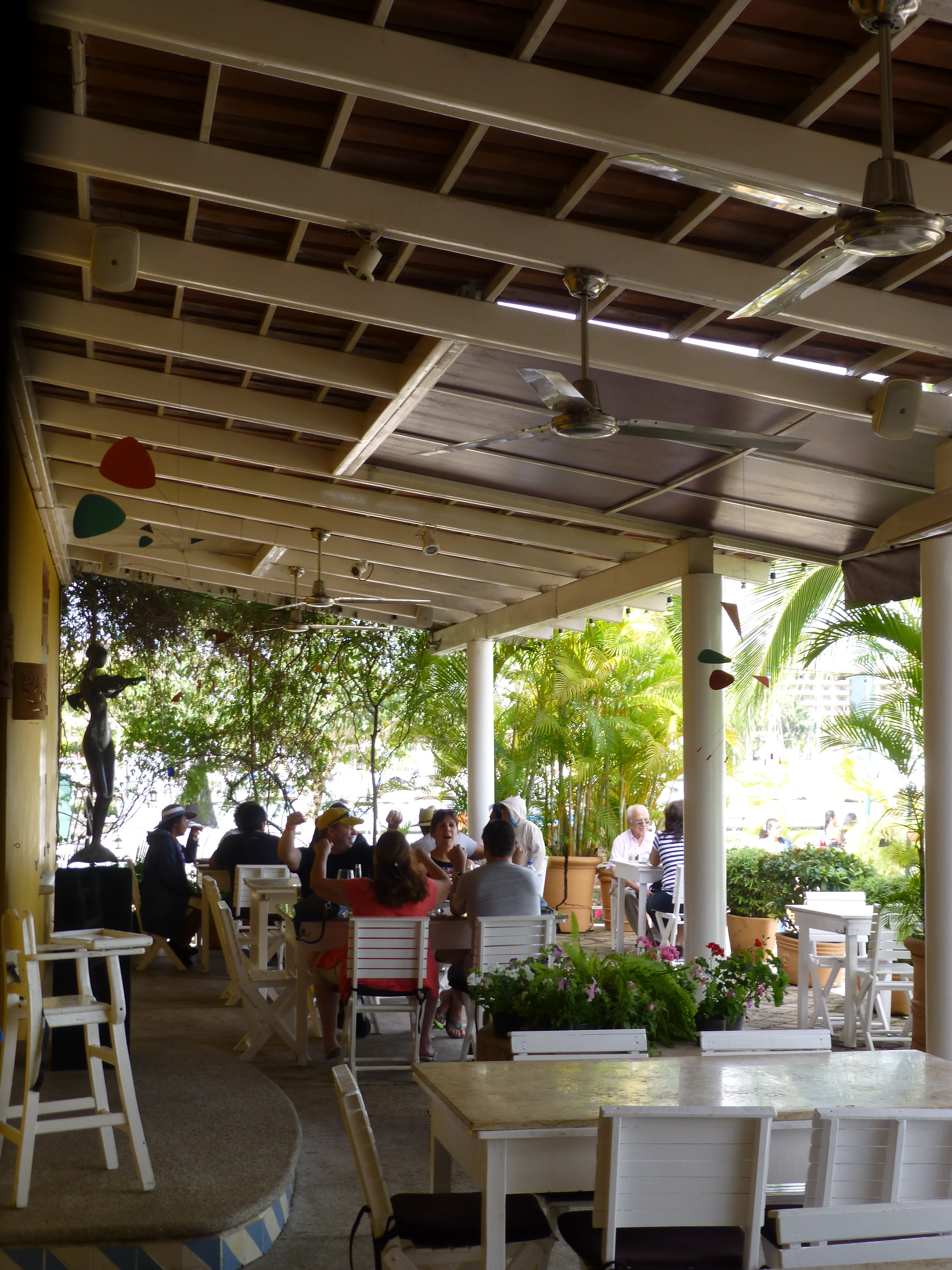 Today the primary focus was a topic with which everyone seemed to view from the same perspective. All were in avid agreement as they discussed the recent exhibit in Mexico City from where the artist, Leon de la Vega, has recentlyjust returned. This significant event was an important auction where part of the proceeds were to benefit the Mexican Institute of Neonatology toward research on children’s learning and therapy and no less to benefit the artist expressing his concerns for the current state of affairs with the lost art of writing by hand.
Today the primary focus was a topic with which everyone seemed to view from the same perspective. All were in avid agreement as they discussed the recent exhibit in Mexico City from where the artist, Leon de la Vega, has recentlyjust returned. This significant event was an important auction where part of the proceeds were to benefit the Mexican Institute of Neonatology toward research on children’s learning and therapy and no less to benefit the artist expressing his concerns for the current state of affairs with the lost art of writing by hand. 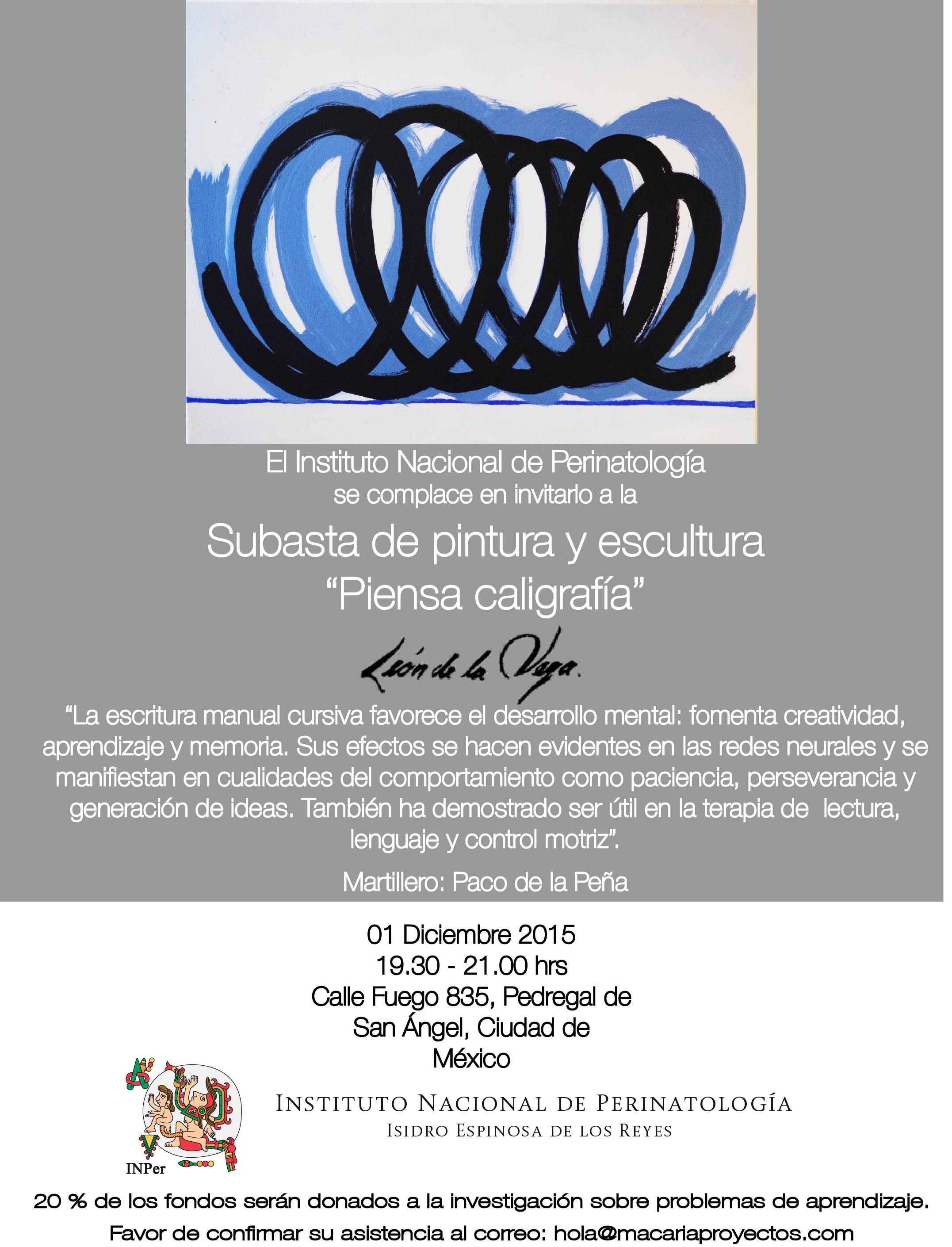
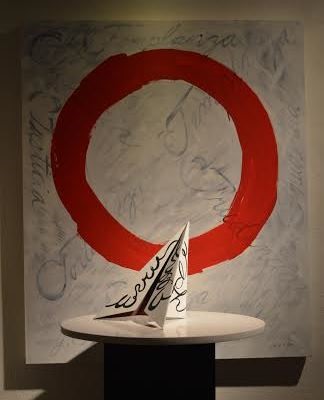
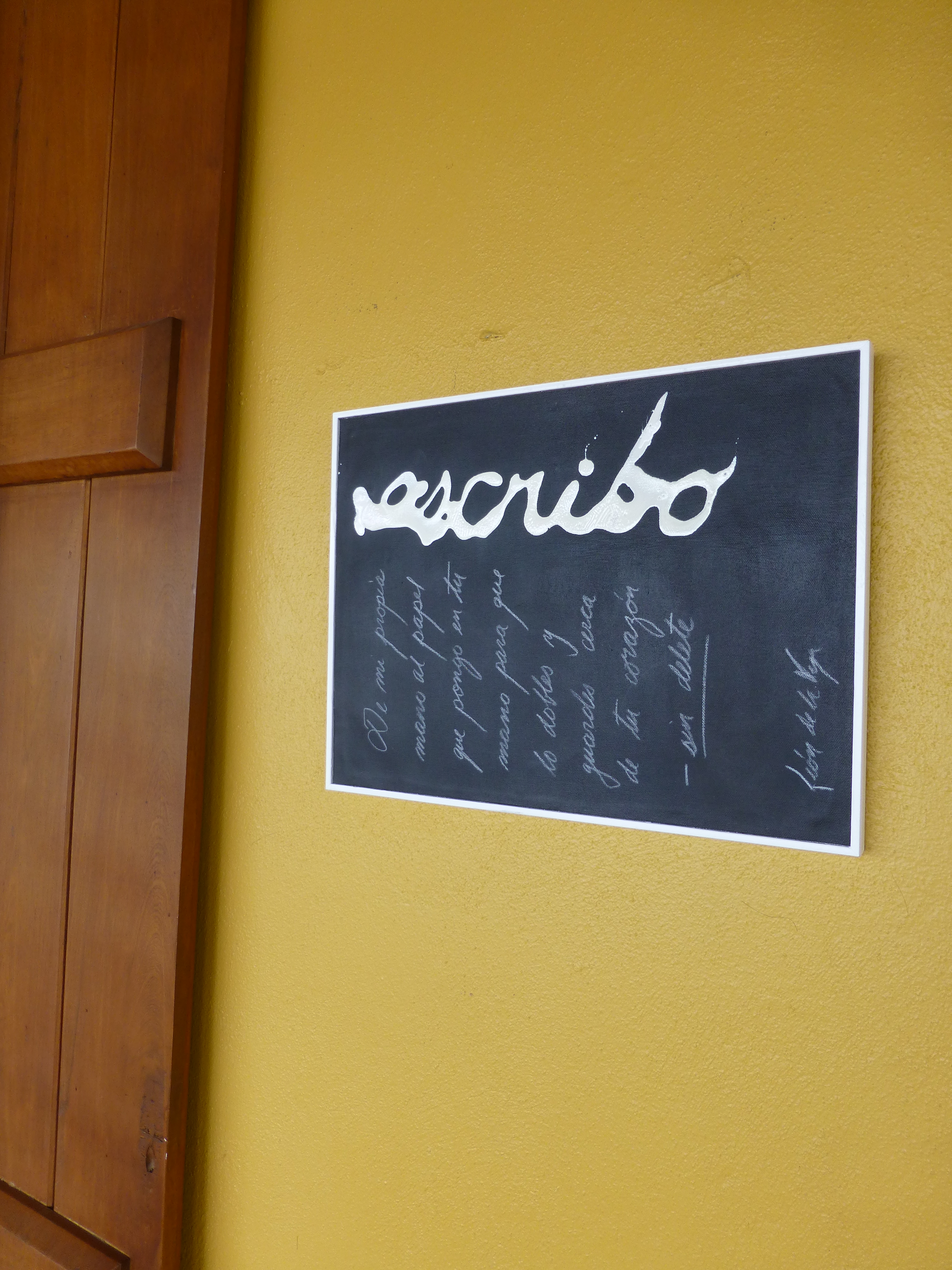


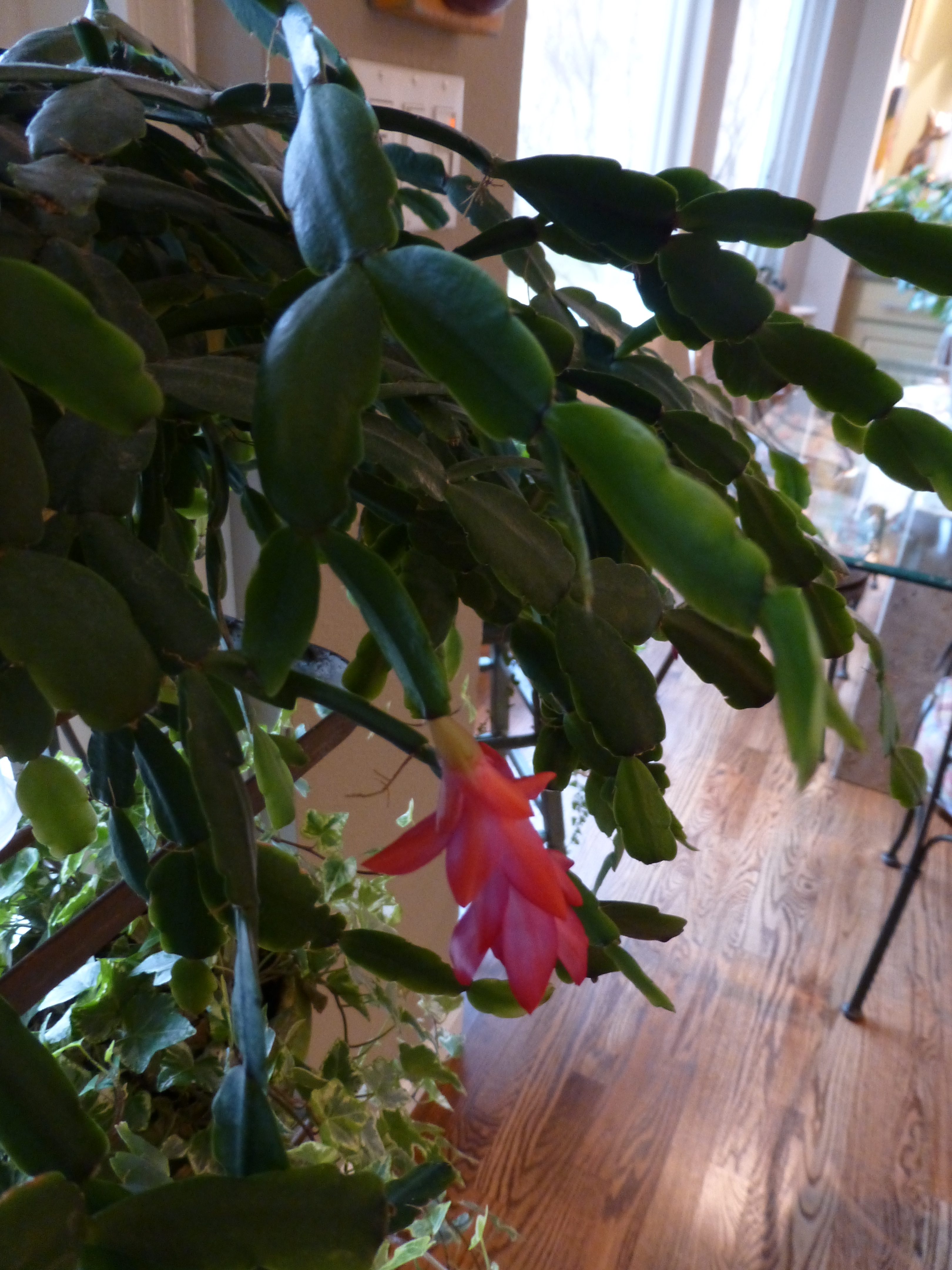
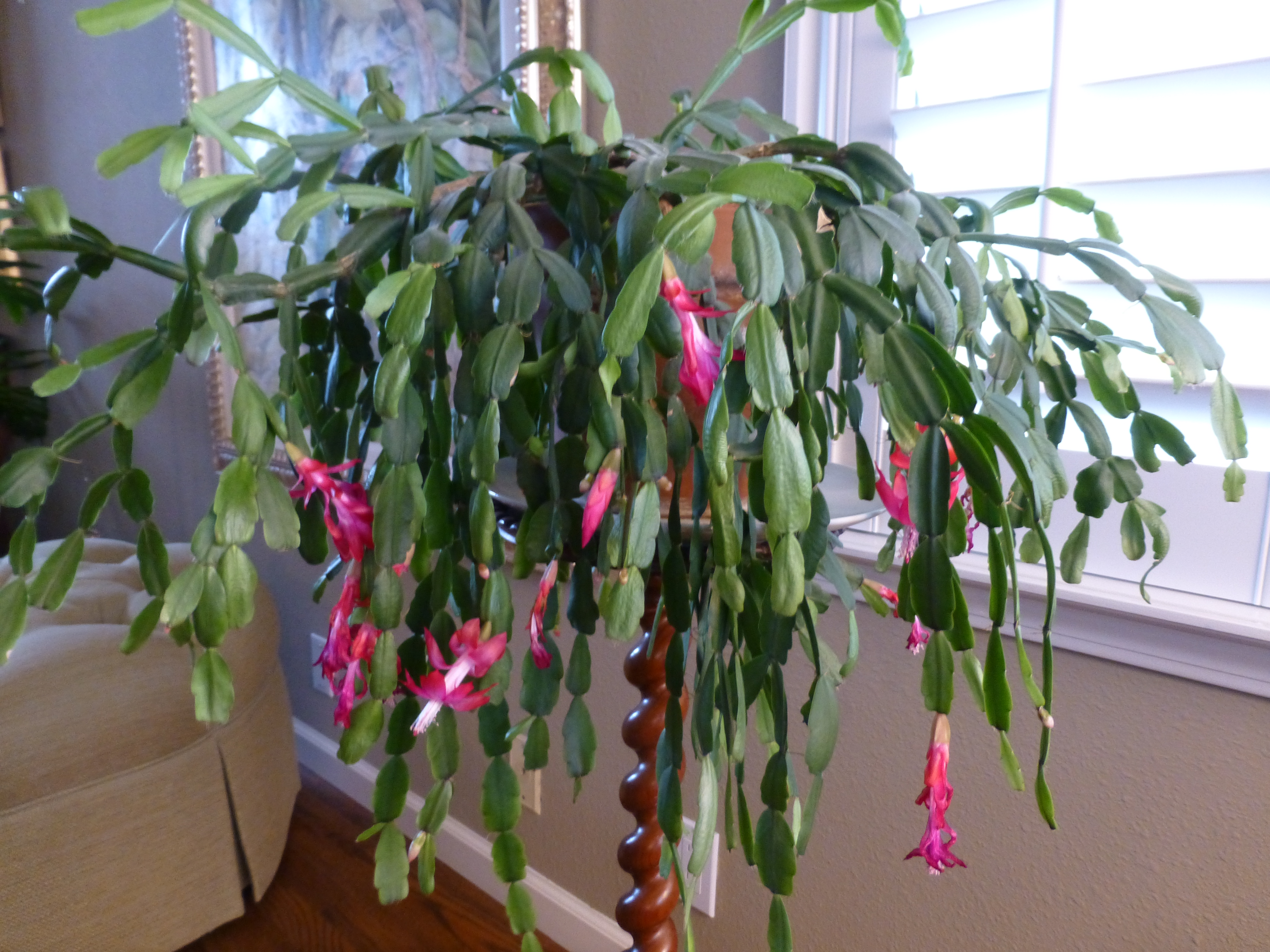
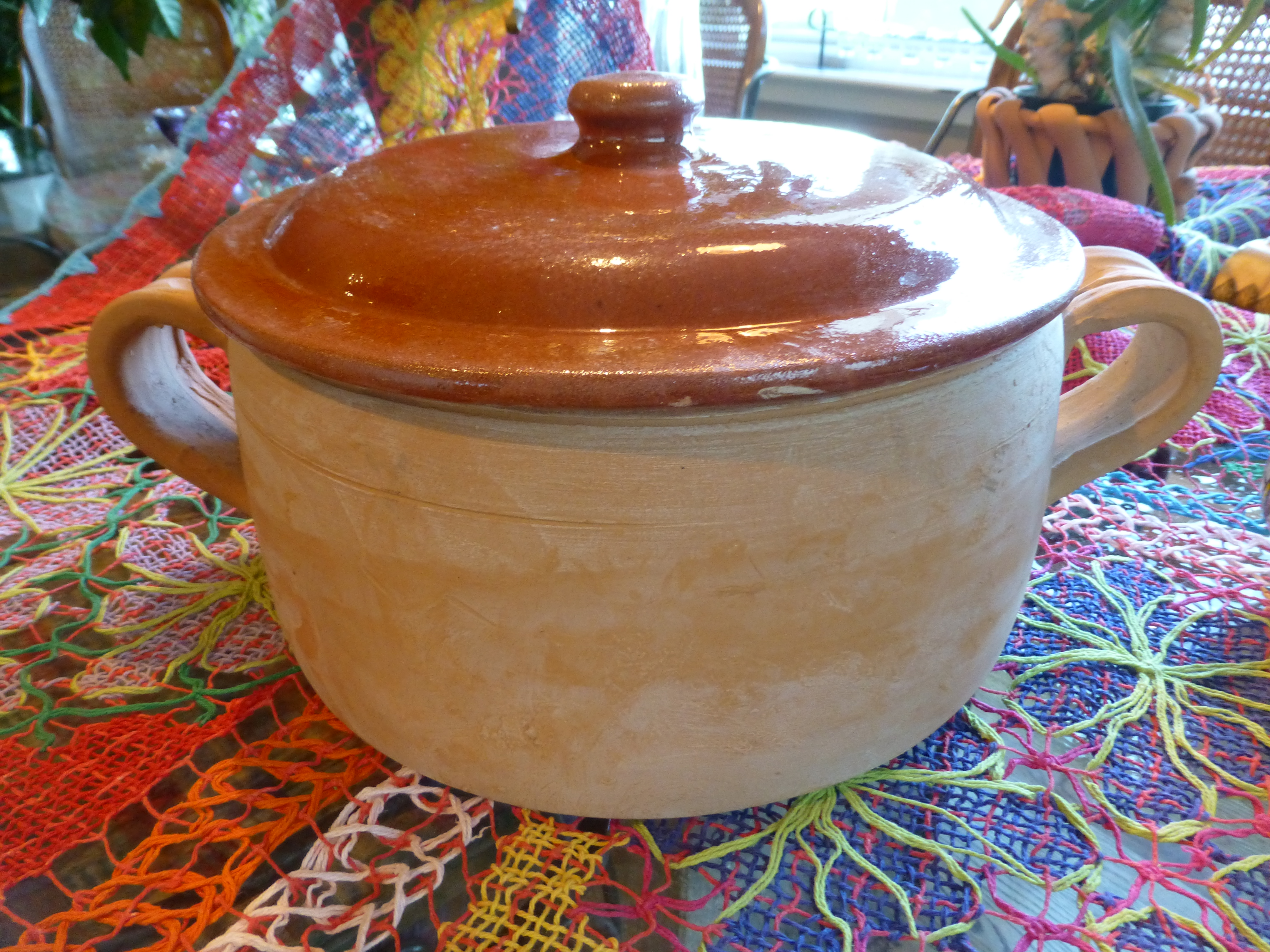 to which I have added many various colors and textures that I enjoy using throughout the year. Christmas is notoriously red and green accented with the bling of silvers and golds. Chanukah is blue and white…but I enjoy all of the colors to celebrate every occasion! So the many hues of the season can be found in the collection of colorful containers and serving pieces, accents and textiles that I often meld to create the festive celebration of the seasons.
to which I have added many various colors and textures that I enjoy using throughout the year. Christmas is notoriously red and green accented with the bling of silvers and golds. Chanukah is blue and white…but I enjoy all of the colors to celebrate every occasion! So the many hues of the season can be found in the collection of colorful containers and serving pieces, accents and textiles that I often meld to create the festive celebration of the seasons. 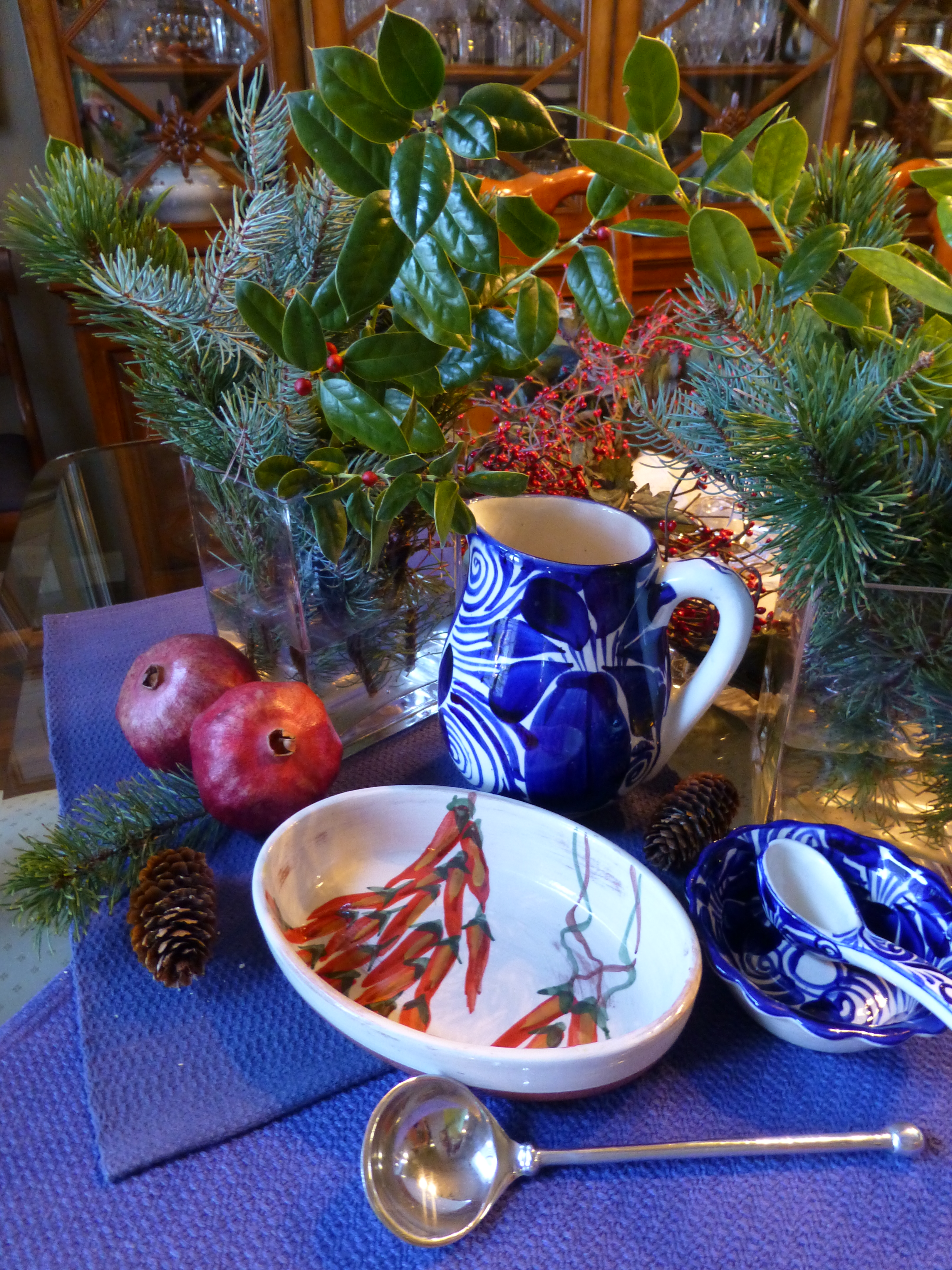
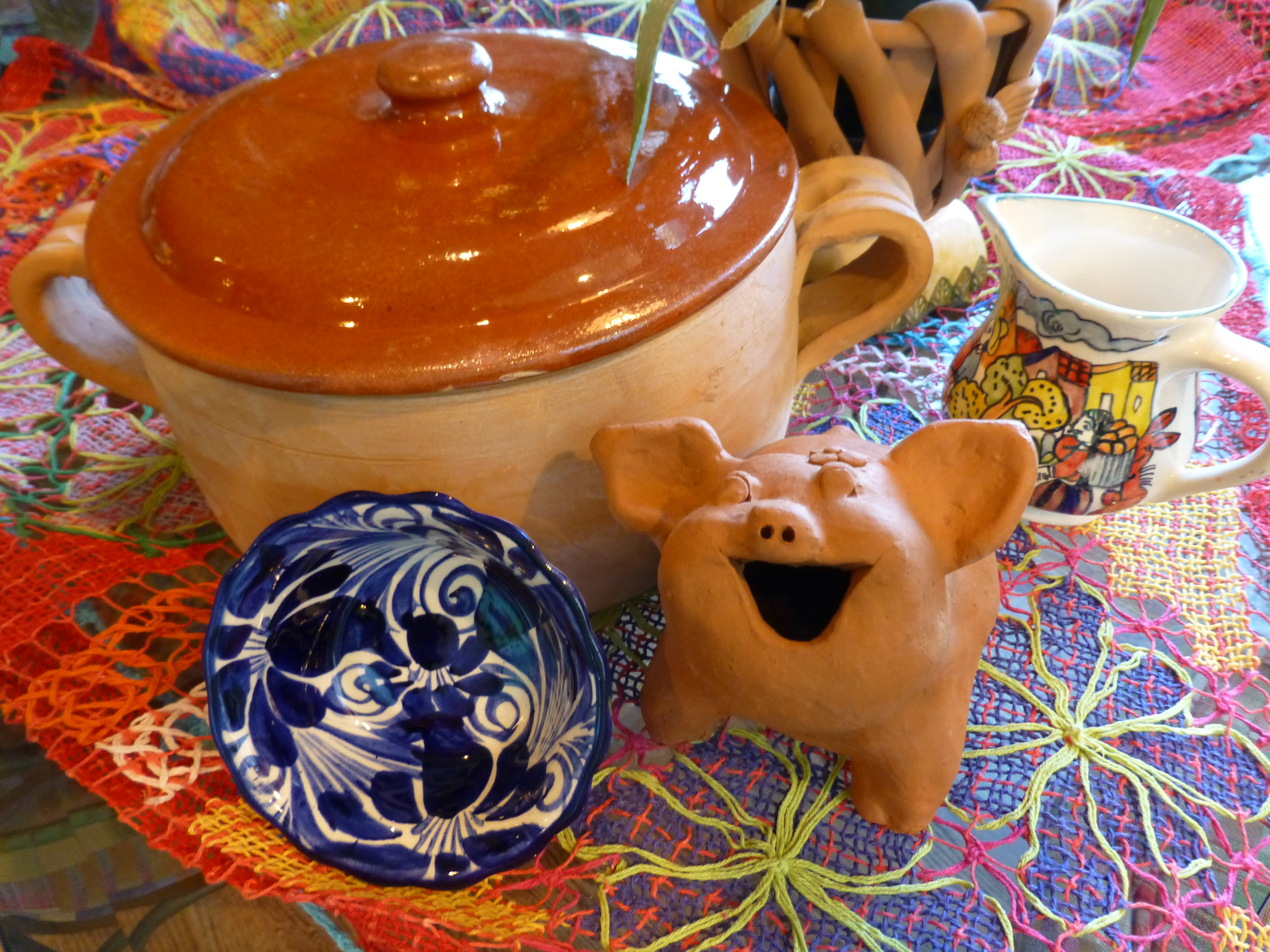 Notice here, the brilliant colors and intricate open-weaving of the Brazilian lace.
Notice here, the brilliant colors and intricate open-weaving of the Brazilian lace.